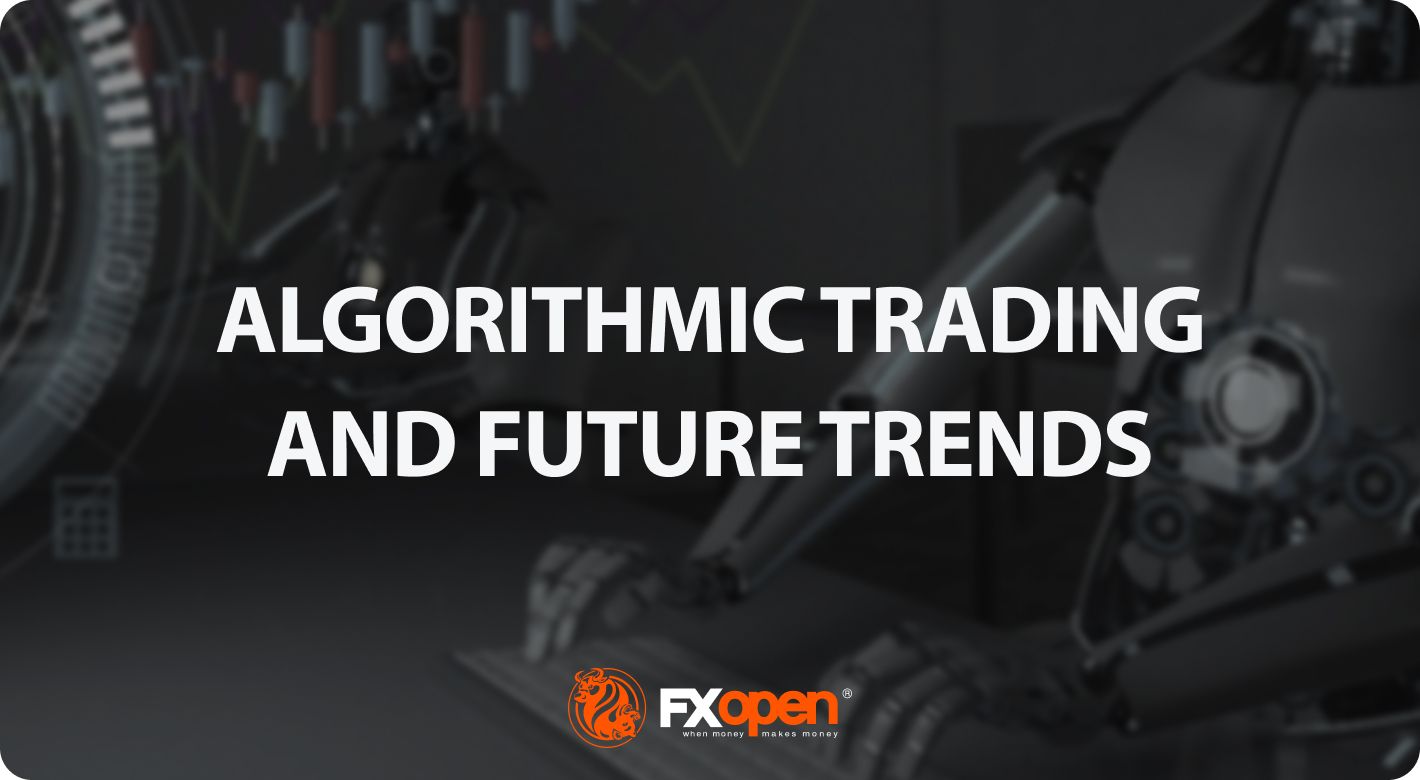FXOpen

Algorithmic trading automates strategies using computer programs. It is crucial in financial markets due to its efficiency and the absence of human errors. This FXOpen article delves into the latest developments in algorithmic trading and explores how an automated trading system can reshape the way people approach trading in different markets.
What Is Algorithmic Trading?
Algorithmic trading, often referred to as algo-trading or black-box trading, is the automated execution of trading strategies using computer programs. Algorithms use predetermined rules, mathematical models, and data analysis to make trading decisions, eliminating the human factor and emotions. This ensures the most efficient trade execution and instant order placement. Theoretically, algo-trading can generate profits at a speed and frequency that is impossible for a human trader, and this can potentially lead to reduced trading fees.
Common Algorithmic Trading Strategies
There are several algorithmic trading strategies that are used by institutional investors, hedge funds, and high-frequency traders to execute trades efficiently and take advantage of different market conditions. Let’s have a look at the best algorithmic trading strategies.
Trend-Following Strategies
One of the best trading algorithms is one designed to follow the current trend. A trend trading algorithm identifies the market direction and capitalises on it. To follow trends, it uses technical indicators such as moving averages or channel breakouts. A trend trading system can, for example, purchase assets when prices are rising and sell when they decline, striving to ride the wave of momentum.
Algorithmic Scalping
Scalping strategies aim to profit from small price fluctuations within a short time frame. Algorithms execute numerous small trades to accumulate gains.
High-Frequency Trading (HFT)
HFT strategies involve executing a large number of orders in milliseconds or microseconds to profit from tiny price differentials. Speed and low-latency technology are crucial in HFT.
Pairs Trading
Pairs trading algorithms identify two related assets and simultaneously buy one while selling the other when they deviate from their historical price relationship.
Sentiment Analysis
Algorithms analyse news articles, social media, and other sources to gauge market sentiment. They may execute trades based on positive or negative sentiment signals.
Trading Range (Mean Reversion)
Mean reversion is an algorithmic trading strategy that aims to capitalise on the tendency of asset prices to return to their average levels after significant deviations. This strategy assumes that if an asset price moves too far away from its historical mean, it’s likely to correct and return to that average level over time.
Benefits of Algorithmic Trading
The importance of algorithms in the financial markets cannot be overemphasised as it has numerous advantages:
- Algorithms execute trades based on predetermined criteria, eliminating the emotional bias often inherent in human traders.
- Algorithms can execute trades at optimal prices and timing, minimising slippage and maximising efficiency.
- Algorithms can process large amounts of data and execute trades in fractions of a second, enabling the use of high-frequency trading strategies, while high-frequency trading can significantly reduce transaction costs.
Challenges of Algorithmic Trading
There are also drawbacks of using algo-trading that need to be considered:
- The development of efficient trading algorithms requires knowledge of quantitative analysis and mathematical modelling.
- Proper implementation of algorithms software may involve significant technical difficulties and infrastructure requirements.
- Rapid market fluctuations can compromise the effectiveness of algorithms. Even the best trend trading system can be called into question.
- Algorithms use historical data and mathematical models, so unforeseen market disruptions, known as black swan events, can disrupt trading.
Future Trends in Algorithmic Trading
It was mentioned above that algo-trading is evolving, so let’s look at what the future may bring to this field.
Advances in technology and computing power. The ongoing development of technology and computing capabilities will continue to drive innovation. Algorithmic trading based on artificial intelligence is real, and many platforms already offer such opportunities.
The rise of machine learning. Machine learning (ML) and artificial intelligence are increasingly integrated into algorithmic trading, enhancing predictive capabilities. ML algorithms can identify complex patterns in vast datasets, helping traders use adaptive trading strategies.
High-frequency trading evolution. HFT strategies are driven by advancements in hardware and algorithms. They rely on executing a high volume of trades in milliseconds (today, even in microseconds or nanoseconds). Traders will seek to optimise HFT algorithms for efficiency, accuracy, and compliance with regulations.
Alternative data sources. Algorithmic traders are exploring unconventional data streams, including social media sentiment analysis, satellite imagery, Internet of Things (IoT) data, and geospatial information. These sources can provide unique insights into market dynamics.
Regulatory changes. Regulators are likely to impose stricter oversight, increased transparency requirements, and enhanced risk management standards. This will be done to enhance the security of both data and money of market participants.
Risk management and cybersecurity. As algorithmic trading gets more prevalent, robust risk management and cybersecurity measures are becoming increasingly important. Trading algorithms must be designed to minimise potential losses, especially during market disruptions or extreme volatility.
Personalisation and customisation. Algorithmic trading is changing towards personalisation and customisation: trading solutions are tailored to individual preferences. Personalised algorithms can be designed to meet specific financial goals, risk tolerance, and the investment horizon of a trader.
Final Thoughts
Algorithmic trading, a sophisticated approach to trading financial assets automatically, is developing rapidly. It has been a game-changer in recent years, and its trends are shaping the future of financial markets. If you want to apply algorithms to your trading, consider opening an FXOpen account. If you prefer to trade yourself, consider using the TickTrader platform with charts and trading tools available to enhance your trading experience.
This article represents the opinion of the Companies operating under the FXOpen brand only. It is not to be construed as an offer, solicitation, or recommendation with respect to products and services provided by the Companies operating under the FXOpen brand, nor is it to be considered financial advice.
Stay ahead of the market!
Subscribe now to our mailing list and receive the latest market news and insights delivered directly to your inbox.








